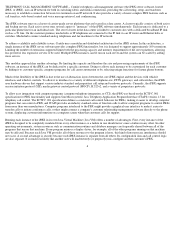8x8 2001 Annual Report Download - page 20
Download and view the complete annual report
Please find page 20 of the 2001 8x8 annual report below. You can navigate through the pages in the report by either clicking on the pages listed below, or by using the keyword search tool below to find specific information within the annual report.Product revenues were $12.8 million in fiscal 2001, a decrease of $8.0 million from the $20.8 million reported in fiscal 2000. The decrease in
product revenues in fiscal 2001 was primarily due to decreases in sales of video monitoring and consumer videophone systems, resulting from
our exit from these businesses, and a decrease in average selling prices for our videoconferencing semiconductors. These decreases were
partially offset by an increase in IP telephony semiconductor revenues resulting from the commercial release of our Audacity-T2 product in
fiscal 2001. Product revenues were $20.8 million in fiscal 2000, a decrease of $5.4 million from the $26.2 million reported in fiscal 1999. The
decrease in product revenues in fiscal 2000 compared to fiscal 1999 was primarily due to a significant decrease in unit shipments of our
consumer videophone systems and average selling prices (ASPs) realized on those shipments. This decrease was partially offset by increases in
unit shipments of our videoconferencing semiconductor and video monitoring system products.
License and other revenues consist primarily of technology licenses, including royalties earned pursuant to such licenses, and nonrecurring
engineering fees for services performed by us for our customers. License and other revenues for fiscal 2001 also included service revenues
resulting from the integration of U/Force's professional services organization after the acquisition of U/Force in June 2000. License and other
revenues increased $853,000, from $4.6 million in fiscal 2000 to $5.4 million in fiscal 2001, due primarily to U/Force professional service
revenues of $1.2 million, offset by a decrease in royalties earned under a license agreement with ESS Technology, Inc. for certain of our video
compression technology, which expired in October 2000. License and other revenues were $4.6 million in fiscal 2000, a decrease of $926,000
from the $5.5 million reported in fiscal 1999, due primarily to a decrease in nonrecurring engineering fees.
Revenues from our ten largest customers in the fiscal years ended March 31, 2001, 2000, and 1999 accounted for approximately 48%, 35%,
and 40%, respectively, of our total revenues. During the fiscal years ended March 31, 2001, 2000, and 1999, no customer accounted for 10% or
more of total revenues.
Sales to customers outside the United States represented 63%, 47%, and 43% of total revenues in the fiscal years ended March 31, 2001, 2000,
and 1999, respectively. Specifically, sales to the Asia Pacific region represented 31%, 24%, and 26% of our total revenues for the fiscal years
ended March 31, 2001, 2000, and 1999, respectively. Our sales to Europe represented 32%, 23%, and 17% of total revenues for the fiscal years
ended March 31, 2001, 2000, and 1999, respectively.
Cost of Revenues and Gross Profit
The cost of product revenues consists of costs associated with components, semiconductor wafer fabrication, system and semiconductor
assembly and testing performed by third-party vendors, and direct and indirect costs associated with purchasing, scheduling, and quality
assurance. Gross profit from product revenues was $7.6 million, $12.3 million, and $2.0 million for the fiscal years ended March 31, 2001,
2000, and 1999, respectively. Product gross margin was 59% for fiscal 2001 and fiscal 2000, compared to 8% in fiscal 1999. The $4.7 million
decrease in gross profit from fiscal 2000 to fiscal 2001 is due primarily to a significant decrease in sales of our video monitoring and consumer
videophone products due to our exit from those businesses. Gross profit in fiscal 2001 was also impacted by lower average selling prices
(ASPs) realized on sales of our videoconferencing semiconductors, offset by a significant increase in IP telephony semiconductor sales. The
significant increase in product gross profit in fiscal 2000 compared to fiscal 1999 was due to an increase in higher margin videoconferencing
semiconductor and video monitoring system revenues and due to higher gross margins realized on sales of our ViaTV products. In addition,
fiscal 1999 gross profit and margins were significantly impacted by a $5.7 million charge associated with the write-off of ViaTV product
inventory due to our decision to cease production of the ViaTV product line and withdraw from our distribution channels.
Gross profit from license and other revenues, substantially all of which were nonrecurring, was $3.7 million, $4.5 million, and $5.4 million in
fiscal 2001, 2000, and 1999, respectively. Associated gross margins were 67%, 97%, and 98% in fiscal 2001, 2000, and 1999. The significant
decrease in gross margin from fiscal 2000 to fiscal 2001 was due to reduced margins associated with our professional service revenues in fiscal
2001. This was a result of lower than expected utilization of our professional services resources and the
16
























